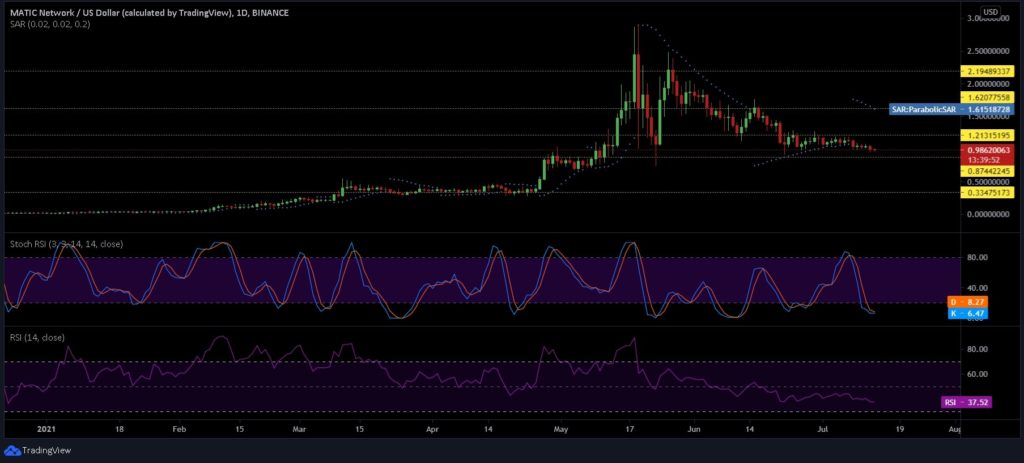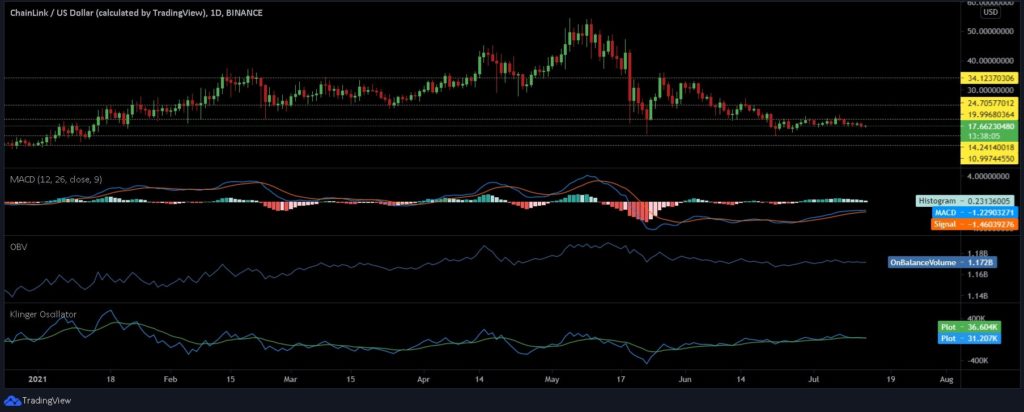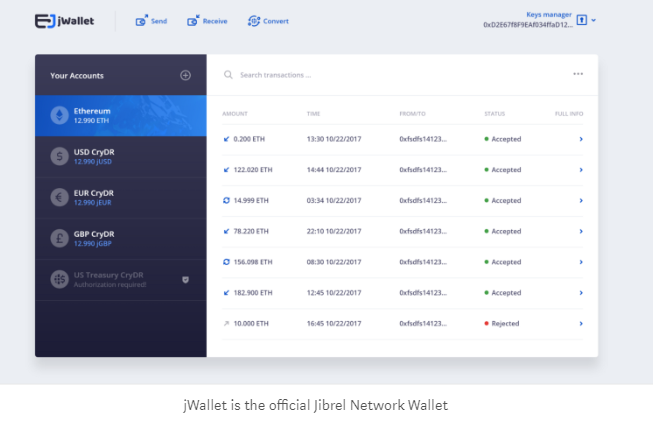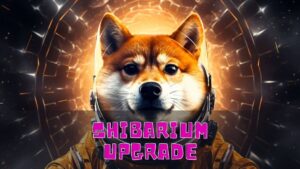Selling pressure has stormed the cryptocurrency market as it drifted back to the lower levels and flashed red. Bitcoin and the rest of the cryptocurrencies are in no mood to break free from its tight consolidation range yet. Polygon [MATIC], Chainlink [LINK], and Solana [SOL] also invalidated bullish cues with the latest correction.
Polygon: Bears continue to anchor MATIC
Polygon [MATIC] was trading near the May levels. The latest bearish pressure slashed its gains which resulted in a weekly decline of roughly 12%. Its price rebound after June low has been impressive. However, the digital asset failed to maintain the necessary momentum. Over the past day, MATIC was down by 3.89% which drove its price to $0.987. With a market cap of $6.27 billion, it recorded a 24-hour trading volume of $453 million.
As the price depreciated slowly, the dotted markers of the Parabolic SAR shifted above the MATIC price candles. The Stochastic RSI is on the verge of a bearish crossover in the extreme oversold region which could mean a reversal to the upside could be in the cards. However, the RSI did not depict a similar sentiment. In fact, it indicated the rising sell pressure as it turned away from the half-line.
MATIC needs to breach the immediate level of resistance at $1.21 to be able to aim big and target other crucial resistance areas of $1.62, and $2.19. On the other hand, the support area for the coin stood at $0.87, and $0.33 respectively.
Chainlink: LINK in the need for credible support
Chainlink [LINK] prices remained on the lower side as it extended its weekly losses to 7.84%. The crypto-asset was currently priced at $17.69 while sitting at a market cap of $617 billion.
LINK broke a key support region this week. The price of the crypto-asset registered an oversold reading on the daily MACD which was at the cusp of a bearish crossover. The OBV indicator has been pretty consistent and has declined slightly after the mid-May fall. Additionally, the Klinger Oscillator [KO] sustained a bearish crossover.
Bears clearly have the upper hand in LINK’s market which could push the token to another level of support at $14.24. If the bulls fail to defend this level, the digital asset risks decline to a low of $10.9. On the flip side, the resistance levels were found to be at $19.9, $24.7, and $34.12 respectively.
Solana: SOL risks testing May lows?
Solana [SOL] is probably one of the few crypto-assets that is yet to test or undercut May lows. However, SOL has been forming lower highs of late which could prove to be a major cause of concern.
The squeezing Bollinger Bands indicated that the price volatility for SOL may remain low over the next trading sessions. The red closing bar of Awesome Oscillator [AO] did not depict a promising momentum in the coin market. Similarly, the Chaikin Money Flow [CMF] also noted a steep decline as the prices fell suggesting a rise in the capital outflow.
First level of resistance stood at the recently established local high of $36.56, while other target points were at $42.14, and $49.4 respectively. Besides, the support level stood untested at $24.86, and $12.75 respectively.
If you found this article interesting, here you can find more Blockchain and cryptocurrency news
La adopción de soluciones blockchain sigue expandiéndose en el sector de las inversiones. De por sí hablar de blockchain es invitar a pensar en invertir. La versatilidad de esta tecnología permite el manejo de instrumentos financieros tradicionales de un modo más seguro y eficaz. Con estas premisas hablaremos acerca de la red Jibrel. La Red Jibrel proporciona monedas, acciones, productos básicos y otros activos e instrumentos financieros como tokens estándar ERC-20 en la cadena de bloques de Ethereum.
La red Jibrel tiene como objetivo facilitar la digitalización, el listado y la negociación de activos tradicionales como monedas fiduciarias, bonos y otros instrumentos financieros, en la cadena de bloques. El banco descentralizado de Jibrel permitirá a los usuarios de la plataforma depositar dinero en efectivo, instrumentos del mercado monetario o crear sus propios recibos de depósito criptográfico (CryDR) y beneficiarse de arbitraje.
Las organizaciones descentralizadas y los fondos que están sobreexpuestos en monedas digitales pueden cubrir sus posiciones y proteger sus fondos con activos estables. Además, Jibrel proporcionará a los desarrolladores una plataforma completa para desarrollar herramientas y aplicaciones para transacciones, inversiones y coberturas, mediante el aprovechamiento de tokens tradicionales respaldados por activos.
Los principales interesados en el ecosistema Jibrel son fundamentalmente los usuarios que no invierten, que buscan beneficiarse del valor desbloqueado por las criptomonedas y la tecnología de blockchain, como las tarifas bajas de remesas y las transferencias instantáneas; también inversores tradicionales que buscan beneficiarse de los altos retornos de la criptoeconomía emergente; y organizaciones descentralizadas, fondos y criptoinversores, que buscan diversificar sus criptomonedas con activos estables de bajo rendimiento. Las necesidades de todos los interesados podrían cumplirse con éxito al llevar la estabilidad de los instrumentos financieros tradicionales a la cadena de bloques.
Solo se requieren cuatro contratos inteligentes clave para que la red funcione de manera efectiva:
Contratos inteligentes de CryDR: Cada activo registrado tendrá un CryDR emitido en forma de un contrato inteligente. Los contratos inteligentes CryDR cumplirán el estándar ERC 20.
Contrato inteligente de banco descentralizado de Jibrel: Un contrato inteligente de JDB dedicado regulará el trabajo de los contratos inteligentes de CryDR.
Contrato inteligente de la Junta Directiva (BODC): El contrato inteligente de la Junta de Directores (BODC) es el único mecanismo para interactuar / influenciar el Contrato de Banco de Jibrel.
Ayudantes / Utilidades (Contratos Inteligentes Auxiliares): Serán contratos inteligentes auxiliares para habilitar funciones tales como el cambio entre contratos que ejecutan diferentes versiones y la habilitación de características API adicionales.
Los CryDRs
Los recibos CryptoDepository o CryDR son tokens que representan el valor de un activo financiero tradicional, denominados en Token de red Jibrel – JNT (por ejemplo, un CryDR USD tiene un valor de JNT de 1 dólar). Se puede usar para remesas, pagos globales, operaciones y cobertura. Los CryDR también se pueden usar para crear instrumentos financieros automatizados y descentralizados, como bonos, productos básicos, instrumentos de deuda y valores.
Con una regulación inteligente, los CryDR tienen reglas incorporadas, tomadas del mundo real y traducidas al código de solidez y desplegadas en ethereum blockchain. Asegurándose de que, aunque descentralizados, los CryDR siempre sigan las reglas y regulaciones del mundo real.
La venta pública de tokens está teniendo lugar desde el 27 de noviembre de 2017 y hasta el 26 de enero de 2018.
El Jibrel Network Token (JNT) se ofrece a un precio de US $ 0,25.
Debido a restricciones legales, los ciudadanos y residentes de los territorios gobernados por los EE. UU. tienen restricciones para participar en la venta de Token de Red Jibrel.













